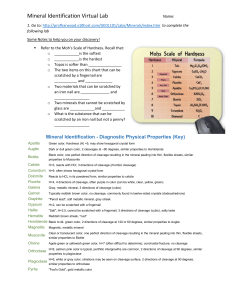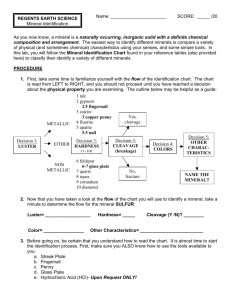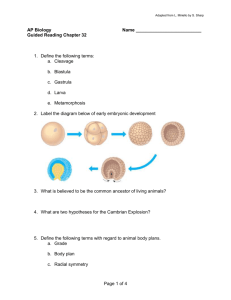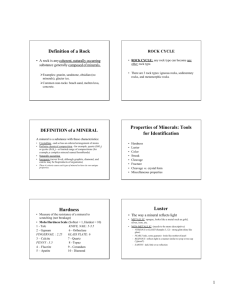minsim2 - charleslansing
advertisement
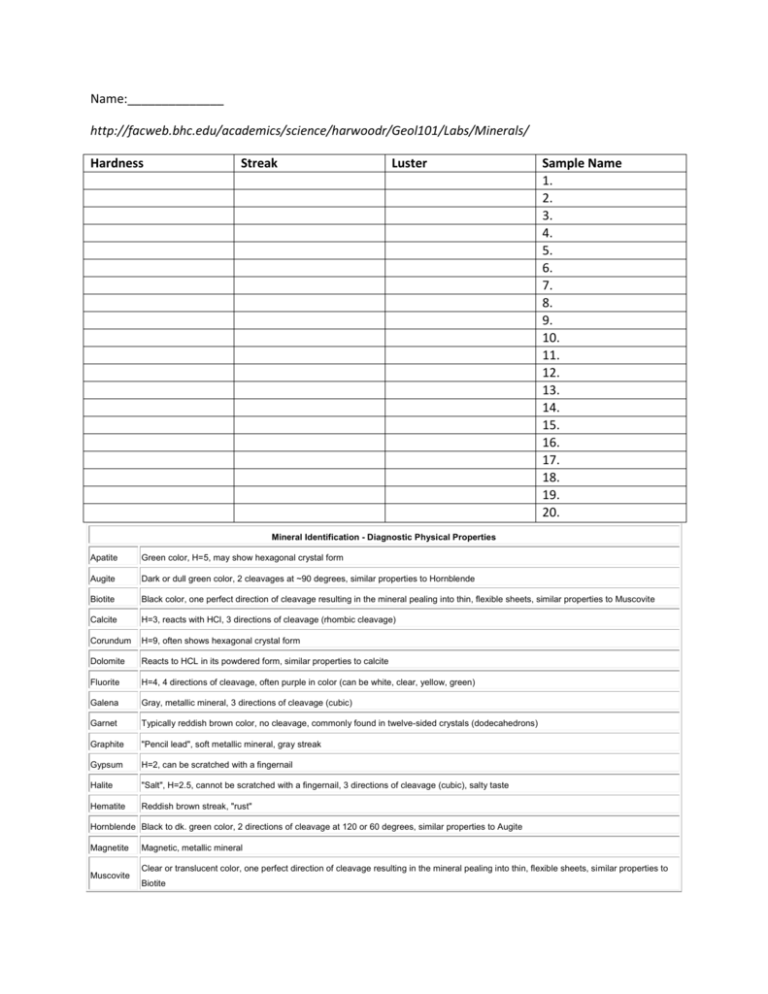
Name:______________ http://facweb.bhc.edu/academics/science/harwoodr/Geol101/Labs/Minerals/ Hardness Streak Luster Sample Name 1. 2. 3. 4. 5. 6. 7. 8. 9. 10. 11. 12. 13. 14. 15. 16. 17. 18. 19. 20. Mineral Identification - Diagnostic Physical Properties Apatite Green color, H=5, may show hexagonal crystal form Augite Dark or dull green color, 2 cleavages at ~90 degrees, similar properties to Hornblende Biotite Black color, one perfect direction of cleavage resulting in the mineral pealing into thin, flexible sheets, similar properties to Muscovite Calcite H=3, reacts with HCl, 3 directions of cleavage (rhombic cleavage) Corundum H=9, often shows hexagonal crystal form Dolomite Reacts to HCL in its powdered form, similar properties to calcite Fluorite H=4, 4 directions of cleavage, often purple in color (can be white, clear, yellow, green) Galena Gray, metallic mineral, 3 directions of cleavage (cubic) Garnet Typically reddish brown color, no cleavage, commonly found in twelve-sided crystals (dodecahedrons) Graphite "Pencil lead", soft metallic mineral, gray streak Gypsum H=2, can be scratched with a fingernail Halite "Salt", H=2.5, cannot be scratched with a fingernail, 3 directions of cleavage (cubic), salty taste Hematite Reddish brown streak, "rust" Hornblende Black to dk. green color, 2 directions of cleavage at 120 or 60 degrees, similar properties to Augite Magnetite Muscovite Magnetic, metallic mineral Clear or translucent color, one perfect direction of cleavage resulting in the mineral pealing into thin, flexible sheets, similar properties to Biotite Olivine Orthoclase Plagioclase Apple green or yellowish green color, H=7 (often difficult to determine), conchoidal fracture, no cleavage H=6, salmon pink color is typical, perthitic intergrowths are common, 2 directions of cleavage at 90 degrees, similar properties to plagioclase H=6, white or gray color, striations may be seen on cleavage surface, 2 directions of cleavage at 90 degrees, similar properties to orthoclase Pyrite "Fool's Gold", gold metallic color Quartz H=7, conchoidal fracture, no cleavage, color is typically white or clear but can be pink, red, purple, black Sulfur Yellow color, "rotten egg" smell if burned Talc H=1, very soft, easily scratched by fingernail http://www.learner.org/interactives/rockcycle/diagram.html 1. 2. 3. 4. 5. Name three igneous rocks: Name three sedimentary rocks: Name three metamorphic rocks: Choose to watch EACH ONE of the provided animations within the Rock Cycle. At the bottom of the page choose the COMPLETE THE ROCK CYCLE hyperlink in red. Show me your score. Log on to Discoveryeducation.com log- in: studentID_cms password: studentID They’re your main minerals: Match the mineral with the item it is used to manufacture and complete the table. 1. (use) 2. 3. 4. 5. 6. Then choose the interactive video in the middle called ROCK CYCLE. Follow the instructions for the video by clicking on the screen when a prompt is given. Use the provided information to answer the following: 1. 2. 3. 4. 5. 6. 7. 8. 9. 10. Rock is a mixture of _______, _______, and ________. What are the types of rocks? Identify 3 forces that can change rocks. What are 2 factors that can lead to weathering? What is erosion and how is it tied into weathering? How can erosion and weathering lead to sedimentary rock layers? How is subduction related to the transition from metamorphic to igneous rock? What Law did Steno help develop? What is the law of horizontality? Illustrate the law of superposition and indicate how is it used for relative dating of layers.


